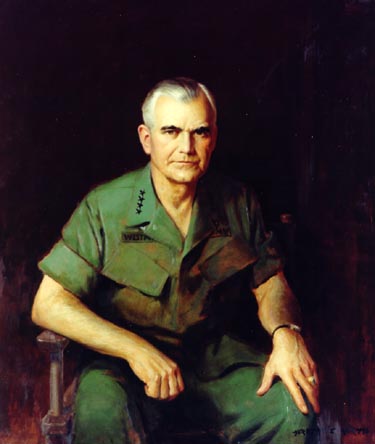
William Childs Westmoreland was born in Spartanburg County, South Carolina, on 26 March 1914; graduated from the United States Military Academy, 1936; was commissioned a second lieutenant, June 1936, and served with the 18th Field Artillery at Fort Sill, 19361939; was promoted to first lieutenant, June 1939; was a battery officer and commander and a battalion staff officer of the 8th Field Artillery at Schofield Barracks, 19391941; was promoted to temporary major (February) and lieutenant colonel (September), 1942; was operations officer of the 34th Field Artillery Battalion, 9th Infantry Division, in the United States and North Africa and a battalion commander in operations in Tunisia and Sicily, 19421944; was executive officer of the 9th Division Artillery in Western European operations, 1944; was promoted to temporary colonel, July 1944; was chief of staff of the 9th Infantry Division in the closing operations of World War II in Germany, 19441945; commanded the 60th Infantry, 19451946; was promoted to permanent captain, June 1946; was chief of staff and later commander of the 71st Infantry Division, 1946; received airborne training at the Infantry School, 1946; commanded the 504th Parachute Infantry, 82d Airborne Division, 19461947; married Katherine S. Van Deusen, 1947; was chief of staff of the 82d Airborne Division at Fort Bragg, 19471950, receiving his promotion to permanent major in July 1948; was instructor at the Command and General Staff College at Fort Leavenworth, 19501951, and the Army War College, 19511952; commanded the 187th Airborne Regimental Combat Team in operations in Korea, 19521953; was promoted to temporary brigadier general, November 1952, and permanent lieutenant colonel, July 1953; was deputy assistant chief of staff, G1, for manpower control, 19531955; attended the advanced management program at Harvard Business School, 1954; was secretary of the General Staff, 19551958; was promoted to temporary major general, December 1956; was commander of the 101st Airborne Division and Fort Campbell, 19581960; was superintendent of the United States Military Academy, 19601963; was promoted to permanent ranks of colonel, June 1961, and brigadier general, February 1963, and to temporary lieutenant general, July 1963; was commander of the Strategic Army Corps and XVIII Airborne Corps, 19631964; was successively deputy commander and acting commander of United States Military Assistance Command, Vietnam, 1964; was promoted to temporary general, August 1964, and permanent major general, August 1965; was commander of United States Military Assistance Command, Vietnam, and United States Army, Vietnam, at the peak of the Vietnam War, 19641968; was chief of staff of the United States Army, 3 July 196830 June 1972; supervised the Armys disengagement from Vietnam, the transition from the draft to an all-volunteer footing, and the employment of troops in a period of active civil disturbance; centered attention upon efforts to improve service life, officer professionalism, job attractiveness, and public understanding; retired from active service, July 1972.
The Artist
Herbert Elmer Abrams (1921) was born in Greenfield, Massachusetts. He studied art at the Norwich Art School in Connecticut and the Pratt Institute in Brooklyn, New York, and under Frank Vincent DuMond at the Art Students League in New York City. A 1942 military draftee, he received pilot training and, by wars end, was an advanced flying instructor for multiengine aircraft. In 1972 he executed five paintings for the Army Art Collection while on commission to cover the Vietnam War. He also painted the portraits of Generals Creighton W. Abrams, Jr., and Bruce Palmer, Jr., for the Armys collection.
William Childs Westmoreland
By Herbert Elmer Abrams
Oil on canvas, 36" x 30", 1972
[140]
